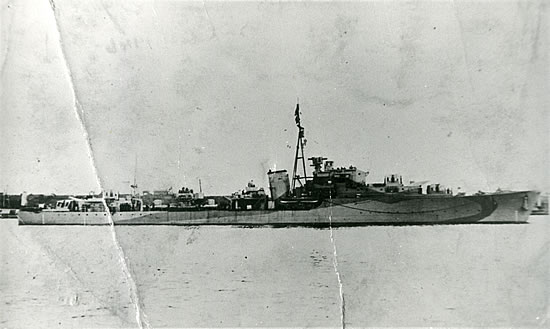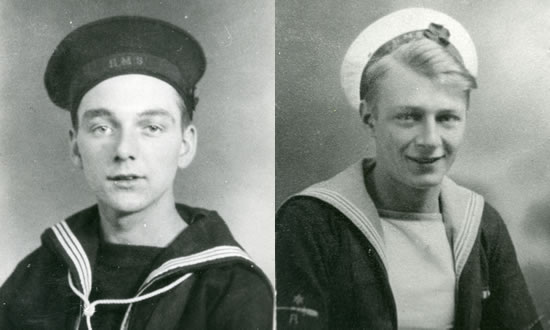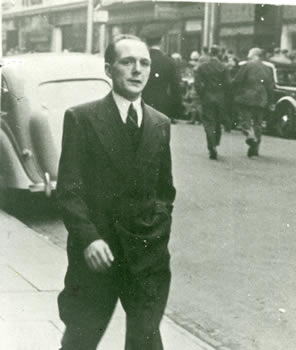Memories Will Never Dwindle
Two Gwent men, Tommy Snook and Doug Western,
recall their time on the Saurmarez at War in the Far East.
By Jim Dyer
First published in the South Wales Argus1987
© Jim Dyer 2012
It was in 1946 that two destroyers, HMS Saurmarez and HMS Volage, were blown to pieces having hit mines laid during the war, between the Greek island of Corfu and the Albanian coast.
Thirty-two sailors died and as it was deemed to be peacetime when the accident occurred their families received no compensation and the victims were forgotten.

HMS Saurmarez
Now some forty years later (1987) it is fitting that at last efforts are being made to recognise these brave men. But for two Gwent men memories of the gallant Saurmarez and her equally battle-hardened crew, will never die.
Training
Caerleon man Tommy Snook was a young blade in his prime when in 1943 he left the merchant navy to train at HMS Raleigh as a bofors gunner. In October of the same year his first posting was to the sleek destroyer HMS Saurmarez as part of the 23rd Flotilla at Scappa Flow. His now long-time pal, Doug Western of Usk, joined the 17,000 tons destroyer in 1944 as a radar operator and both were to see plenty of action before demob.

Tommy Snook (left) and Doug Western
It was Tommy Snook who got an early baptism into war when the ship was involved with the sinking of the mighty German battleship Scharnhorst in 1943 off Norway.
This huge ship, displacing some 26,000 tons, was a frightening prospect for shipping and had already sunk the armed British cruiser Rawalpindi. However things were different when she decided to attack the Russian convoy JW55B.
After a game of cat and mouse she was finally sunk by the battleship Duke Of York and the cruiser Jamaica. The Sautmarez was part of the attacking force and Tommy recalls picking-up survivors after the tremendous battle.
Russian Convoys
The Saurmarez was involved in many Russian convoy escort duties mainly in atrocious weather. He says ' The U-boats and planes used to attack off the North Cape and Bear Island and sometimes we had to do sweeps off there to bring the ships around there safely.
'The weather was so rough once we had to turn back. Even the planes in the aircraft carriers couldn't take off. Being in any Arctic convoy was horrendous and not just because of the U-boats. During 'cruising stations' half hour on watch and half hour off it was so cold they gave us masks to protect our faces. When the waves hit the ship it turned to ice and stuck to your skin causing a lot of pain. We had high-powered lookout glasses 14 miles range and these would freeze-up too. The water was green and the rolling of the ship terrific.'
He had sad memories of the merchantmen too. 'There were plenty of ships going down and if it was an ammunition boat there would be one great flash and it would be gone. Once I was looking at a ship through the glasses and I could see aircraft on the deck and men walking around. They next second they were gone: blown-up.'
Mermansk he thought a little like Blaenavon but he and Doug did many trips there on their destroyer, a frozen and inhospitable place.
Skirmishes
Soon though they were heading for warmer climes, the Indian Ocean, with the 26th Flotilla after a refit at Tyneside and a Bofors gun at Greenock. But there were the D-Day landings nearer home to be dealt with first.
The Saurmarez covered the Plto beachhead bombarding the shores and watching the soldiers get off safely. When they did steam eastwards it was in company with sister ships Venus,Virago, Vigilant, and Verulem, later scrapped at Cashmore's Newport.
Tommy and Doug tell some electrifying stories about the skirmishes among the many islands around India and Java, like the time their destroyer and three others bombarded Port Blair in the Andaman Islands. Coming around to the Nicobars looking for coastal junks supplying the Japanese, they had a narrow escape when they entered Stuart Sound and proceeded to bombard the shore batteries.
'We were so close we could touch the trees. Unfortunately, the old ship ran aground and we were in a bad position. Gradually we eased ourselves out all the while being fired at, and went alongside the Rapid. The Volage laid a smoke screen. There were many wounded and the surgeon operated all night in the mess deck.'
They were able to rejoin the Flotilla at Akyab, Burma but the Volage and the Rapid were damaged and out of action.
Japanese Battleship
They met a Japanese convoy with three small gunboats and sank it. They picked-up the survivors - Sumatran women and the Japanese crew who lived-up to their fanatical reputations. 'You had to watch them all the time. One killed himself by putting his head between two rolling depth-charges. there were another two on a floating oil drum but though we threw them a line, they wouldn’t take it.'
It was in the midst of a tropical rainstorm when the Saurmarez faced its most daunting task of the war when on May 15th, 1945 a young radar operator on the Venus picked-up something strange on the screen. In fact it was brilliantly spotted as the enormous 1,200 tons Japanese heavy cruiser Haguro was steaming towards them
The Saurmarez was flotilla leader and her captain, M.L.Power resolved to engage her with five destroyers, being fully aware that the ten eight-inch guns of the big cruiser could easily outrange them.
Two other Newport boys, Yalland and Rudge, were aboard that day. Tommy had vivid memories having been at in his gunnery post at the time. 'The noise was terrific and we were within 1,000 yards of her. Our first four torpedoes missed but we finally sank her. It was a brilliant attack and the captain should have got the VC. We only lost three crew although we took three direct hits including one which didn't explode.'
Pirates
The next day they fought off a Japanese air attack and rejoined a jubilant flotilla.
When they returned to Ceylon they were cheered by the rest of the ships there and received a similar reception a little later at Durban, South Africa.
For the rest of the war the Saurmarez patrolled the Indian Ocean and all points east, at one time searching for pirates in the South China Sea. At Penang they saw further evidence of the fanatical Japanese with their abandoned suicide boats lining the harbour.
But the war was soon to end and after only a few, but thrilling, years, Tommy and Doug came back home. The HMS Saurmarez went on to a sad end at Corfu but her seasoned crew and the courageous little destroyer herself will not be forgotten by these two Gwent men.

Tommy Snook after demob
Jim Dyer - 25the December 2011
NOTE
Article first published on 19th June 1987 in South Wales Argus.